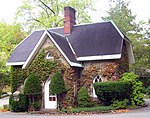H. D. Champlin & Son Horseshoeing and Wagonmaking

The H. D. Champlin & Son Horseshoeing and Wagonmaking shop building is located on Main Street (NY 301) in Nelsonville, New York, United States. It is a typical commercial structure for a common business of the late 19th century that survives in good condition. In 1982 it was added to the National Register of Historic Places. Champlin started his business in 1858 in a building on nearby Spring Street behind the present property. His name does not show up on maps at that site until 1876, and only by 1912 does the current, one-story brick building appear on any map of the village.The entranceway was expanded and a larger door installed at some point before then. It is used today as a garage.
Excerpt from the Wikipedia article H. D. Champlin & Son Horseshoeing and Wagonmaking (License: CC BY-SA 3.0, Authors, Images).H. D. Champlin & Son Horseshoeing and Wagonmaking
Main Street,
Geographical coordinates (GPS) Address Nearby Places Show on map
Geographical coordinates (GPS)
| Latitude | Longitude |
|---|---|
| N 41.424444444444 ° | E -73.947222222222 ° |
Address
Main Street 280
10516
New York, United States
Open on Google Maps











